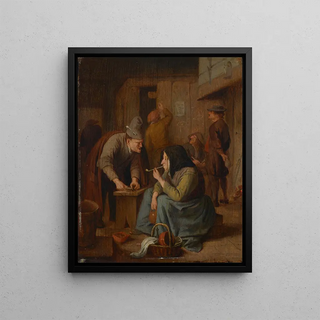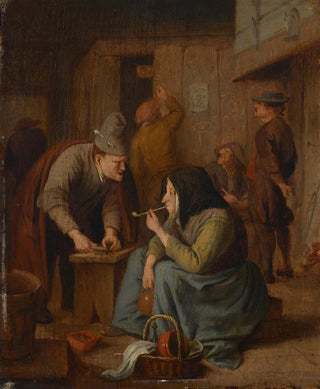Art print | An interior of a tavern with a woman smoking a pipe and a man cutting tobacco - Jan Steen


View from behind

Frame (optional)
In the vibrant world of 17th-century Dutch painting, Jan Steen's work stands out for its ability to capture the very essence of everyday life. "An interior of a tavern with a woman smoking a pipe and a man cutting tobacco" is a compelling example. This intimate scene, where conviviality and simplicity intertwine, transports us to a time when taverns were gathering and exchange places. Steen's lively composition invites the viewer to immerse themselves in the warm atmosphere of this interior, revealing the nuances of human interactions while celebrating the simple pleasures of life.
Style and uniqueness of the artwork
Jan Steen's style is characterized by meticulous attention to detail and a rich, warm color palette. In this piece, light plays a crucial role, illuminating the faces of the characters and creating an ambiance that is both lively and inviting. The expressions of the protagonists, joyful yet contemplative, demonstrate a keen observation of human nature. Steen excels in rendering each element of the scene meaningful, whether it is the carefully cut tobacco or the smoking pipe, symbols of conviviality and shared pleasures. The elements of the composition, arranged with remarkable mastery, form a lively tableau that encourages reflection on the customs of his time.
The artist and his influence
Jan Steen, born in 1626, is often regarded as one of the masters of Dutch genre painting. His work reflects not only his artistic talent but also a deep understanding of the society of his era. Steen captured the nuances of daily life with such finesse that he became a reference for artists who followed. His approach, blending humor and social critique, expanded the scope of genre painting, making it accessible and relevant. The scenes of taverns, festivities, and gatherings he depicts are as many testimonies of a time when pleasure and conviviality played a central role in people's lives. Thus, Steen's influence endures,

Matte finish

View from behind

Frame (optional)
In the vibrant world of 17th-century Dutch painting, Jan Steen's work stands out for its ability to capture the very essence of everyday life. "An interior of a tavern with a woman smoking a pipe and a man cutting tobacco" is a compelling example. This intimate scene, where conviviality and simplicity intertwine, transports us to a time when taverns were gathering and exchange places. Steen's lively composition invites the viewer to immerse themselves in the warm atmosphere of this interior, revealing the nuances of human interactions while celebrating the simple pleasures of life.
Style and uniqueness of the artwork
Jan Steen's style is characterized by meticulous attention to detail and a rich, warm color palette. In this piece, light plays a crucial role, illuminating the faces of the characters and creating an ambiance that is both lively and inviting. The expressions of the protagonists, joyful yet contemplative, demonstrate a keen observation of human nature. Steen excels in rendering each element of the scene meaningful, whether it is the carefully cut tobacco or the smoking pipe, symbols of conviviality and shared pleasures. The elements of the composition, arranged with remarkable mastery, form a lively tableau that encourages reflection on the customs of his time.
The artist and his influence
Jan Steen, born in 1626, is often regarded as one of the masters of Dutch genre painting. His work reflects not only his artistic talent but also a deep understanding of the society of his era. Steen captured the nuances of daily life with such finesse that he became a reference for artists who followed. His approach, blending humor and social critique, expanded the scope of genre painting, making it accessible and relevant. The scenes of taverns, festivities, and gatherings he depicts are as many testimonies of a time when pleasure and conviviality played a central role in people's lives. Thus, Steen's influence endures,






